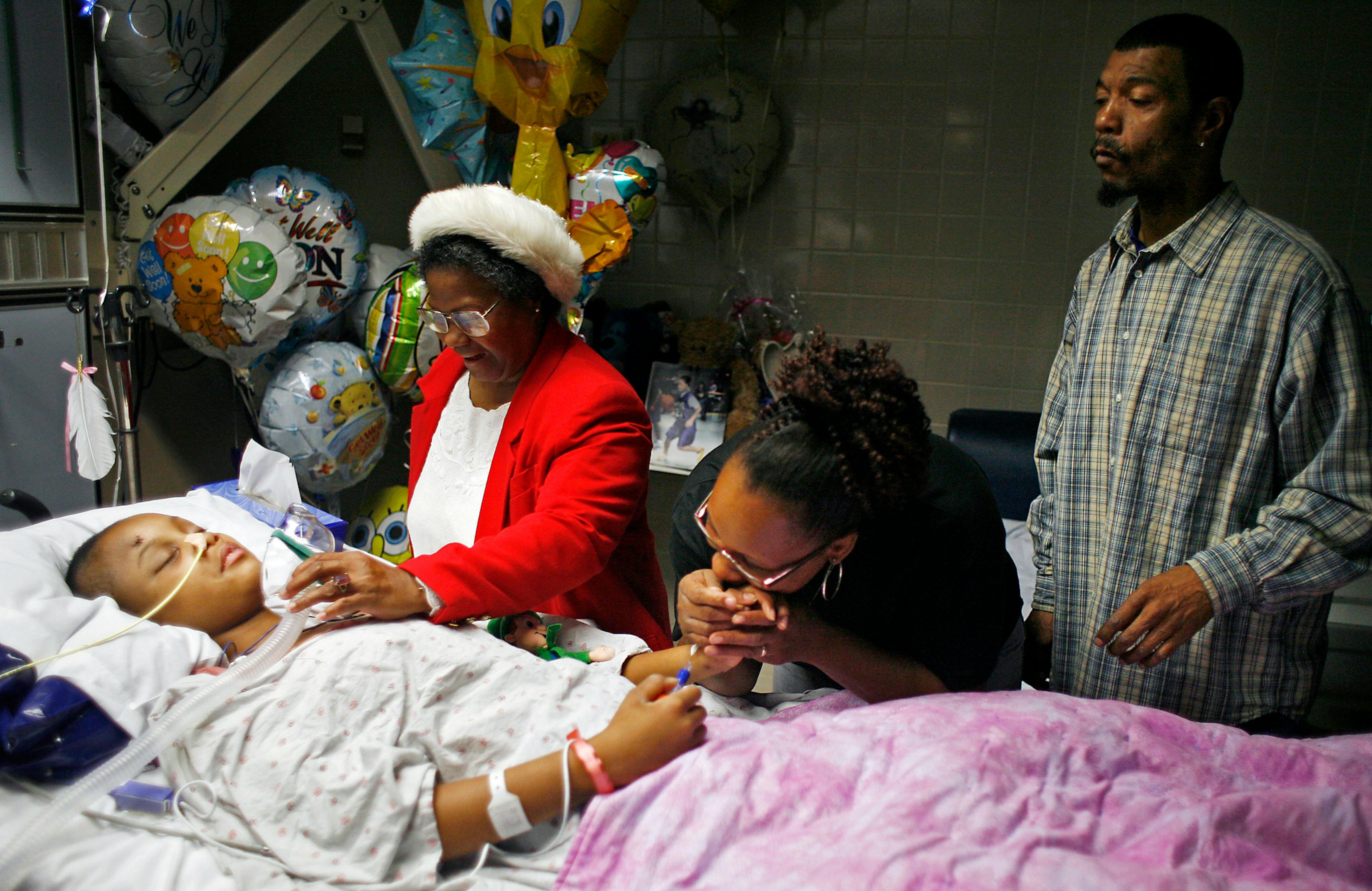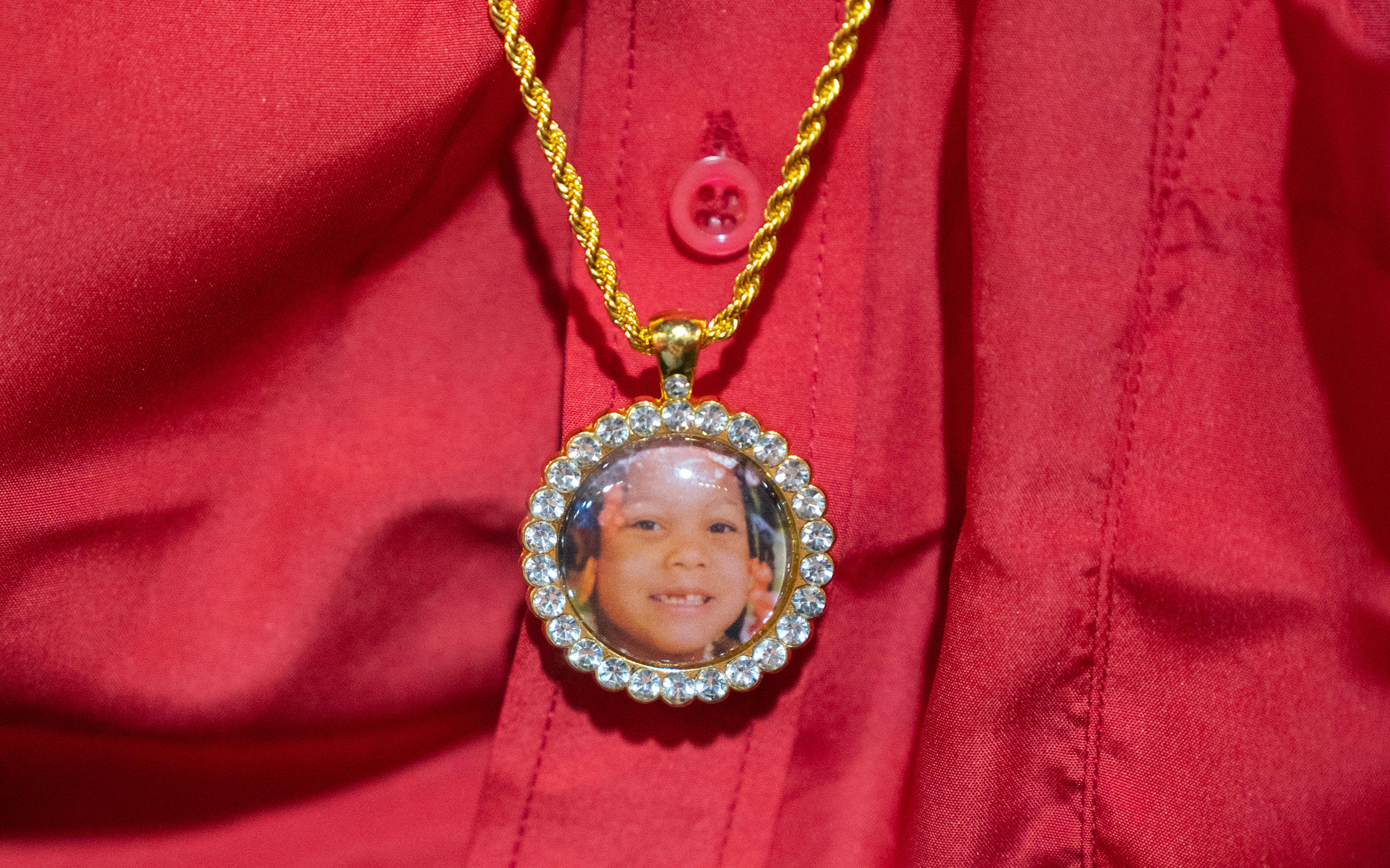Star Tribune
An errant bullet nearly killed her 17 years ago. But Vernice Hall was determined to live.

Vernice Hall had always beaten the odds.
Doctors never expected her to survive the bullet that ripped through her brain one night in 2007, just steps away from her north Minneapolis home. They counseled her parents to prepare for the worst. Instead, the couple prayed for a miracle.
Vernice hung on. The 12-year-old fought through multiple surgeries to remove a piece of her skull and spent weeks on a ventilator. Eventually, she regained consciousness. But the shooting left the once vibrant little girl with massive brain damage that required round-the-clock care, stealing her ability to walk or talk.
Despite her disability, Vernice — better known to friends and family as Star — found creative ways to communicate her needs and express her love. She earned a high school diploma, danced to Beyoncé and never lost her fiery disposition. Over the next 17 years, she surpassed each grim prognosis, modeling a form of resilience and strength that often shocked medical staff and her own family.
“Every time they tried to count her out,” said her older sister, Temeka Wickliffe, “she proved them wrong once again.”
Star died after a short illness Feb. 16 at her mother’s house in St. Paul. She was 29.
An autopsy is pending. If the medical examiner rules that her death was caused by complications from the gunshot wound, Minneapolis Police will reopen the case as a homicide.
A stray bullet
On Sept. 22, 2007, Star was sitting on the stoop outside her house on the 1800 block of Oliver Avenue N., where several dozen relatives had gathered for a party. When she got up to escort a friend down the block, a series of shots pierced the air.
One round, intended for another target, struck Star’s forehead. Her 14-year-old brother threw himself over her body. Their father ran outside to find them. His “Lil Star” lay still.
“I lost it,” Steve Hall told the Star Tribune at the time. Two years earlier, Hall’s 18-year-old son was shot dead in Milwaukee.
He could not contemplate their daughter meeting the same fate. But here she was, hospitalized in critical condition, because of senseless violence between idle youth. The spunky seventh-grade basketball player who loved Spanish class, hip-hop and the cartoon “SpongeBob SquarePants” might never wake up.
So Star’s parents took a leap of faith. Steve and Vernice’s mother, Latice Smith Hall, married at her bedside the same day they decided to pull her off the breathing machine. Their older children crowded the hospital room to watch their exchange of vows.
Minutes later, Star opened her eyes.

Photo by Richard Tsong-Taatarii, Star Tribune
Minister Lucy Johnson, left; Star’s mother, Letice Smith Hall; and her father, Steve Hall, at Star’s bedside at HCMC in 2007.
‘Every single day I cried’
In the aftermath of the shooting, witnesses told Hall that they saw four young men climb out of a black truck, wait behind a fence and fire on several people as they left the party around midnight. Police suspected Star had gotten caught in the middle of a gang dispute.
Within 48 hours, investigators nabbed two teenagers in connection with the case. Both were charged as adults with attempted first-degree murder. Yet, Star would never see justice in court.
One 17-year-old boy was acquitted at trial. (Even Steve Hall publicly doubted his guilt.) Then-Hennepin County Attorney Mike Freeman speculated that witnesses were intimidated into changing their stories on the stand. He vowed to prosecute the co-defendant, 18-year-old Tywin Marcell Bender.
Two months later, Freeman’s office was forced to dismiss the charges, citing the reluctance of witnesses to testify — though he remained convinced that Bender pulled the trigger. The news came as a blow to Star’s family, who’d been led to believe that the case against Bender was stronger.
“Whoever did this, they will be dealt with,” Hall said in 2008. “God is not going to let them get away with it.”
Both teens maintained their innocence. But Bender continued to have scrapes with the law. In 2016, he was sentenced to 10 years in prison following convictions for firearm violations and plotting to retaliate against two federal witnesses who testified against a gang leader. He remains incarcerated at a federal penitentiary in Marianna, Fla.
The outcome lacked closure and it became difficult to find peace, especially in the early days of Star’s recovery.
“Every single day I cried,” Smith Hall recalled in a recent interview. “Every time I look at her, every time I change her, I feed her and think: ‘Who did this to my baby?'”


Photos by JENNIFER SIMONSON, Star Tribune
Despite a serious brain injury, Star was able to learn to communicate without speaking. During her recovery, she responded best to the voice of her father, at right.
‘She didn’t stop living her life’
After 112 days in the hospital, Star was finally cleared to go home.
Progress during daily physical therapy sessions had been slow. The massive brain injury robbed her of complex cognitive functions, but over time, Star was able to regain some basic response skills and recognize her family and friends.
She learned to blink to communicate — one long blink meant yes; two short blinks meant no — raise her right arm to wave, give hugs and reach for objects. Medical staff noticed that Star reacted more to her father’s voice than others, so he became a constant at her side, gently pushing Star during sessions. He taught her how to snap her fingers.
As time passed, their other children began to ask whether Star would ever speak again. The Halls were hopeful, but knew the truth. They focused their energy on providing the best level of comfort and care to their daughter they could, tending to her feeding tube and constantly readjusting her limbs to avoid bedsores.
Every morning, Star greeted them with a big smile.
But the stress and sorrow of the shooting took its toll. Steve Hall unexpectedly died two years later, at age 46, leaving his wife as Star’s primary caregiver.
“He cried himself sick,” Smith Hall said, wiping away tears. “I had to stay strong because I had to take care of her.”
Between school and weekly therapy sessions, Star wiled away the hours binging reality TV with her mom — she loved “The Real Housewives of Atlanta” and the Kardashians — and dancing to power ballads with her siblings. She happily tracked her young nephews with her eyes when they came over to play, zooming matchbox cars around her wheelchair.
Star always knew how to get attention and articulate her mood. “If she was mad at you, she’d kick you,” her younger sister, Elexus Hall, said with a chuckle.
Later on, an electronic tablet helped Star vocalize commands. One button announced that she was hungry, another declared that she’d like to hear some music. Her favorite: “Hi, my name is Star!”
“She had very expressive eyes, so her eyes would always tell you the story,” said Elliot Foster, a direct support provider who spent the last three years transporting Star to medical appointments and social activities.
During regular visits to Gillette Children’s Hospital in St. Paul, where Star received Botox injections to increase flexion in her legs, Foster put on impromptu Beyoncé concerts to distract her during the procedure. He played the songs on his phone and belted the lyrics in a sing-a-long beside the staff.
Occasionally, when he buckled her seatbelt, Star would playfully knock off his hat.
“What she could show you of her personality, she showed off,” he said, admiring her spirit. “Even after everything that happened, she still didn’t stop living her life.”
Photos by Alex Kormann, Star Tribune
Loved ones gathered at Star’s funeral at Shiloh Temple in Minneapolis on Feb. 27.
A life of ‘tragedy and triumph’
Funeral services were held last week at Shiloh Temple on West Broadway, the Northside church that adopted the Hall family during their darkest hour. Its congregants welcomed Star home from the hospital after the shooting and helped them navigate a torrent of grief in the years to come.
As the Rev. Arnetta Phillips examined the room of mourners dressed in red — Star’s favorite color — she sought to soothe the family’s pain once more, extolling the blessings of time.
“The doctors had given up on Star and said she wasn’t gonna live past the night,” Phillips said. “God gave her 17 extra years.”
In return, she said, Star taught them endurance and the strength to overcome life’s greatest obstacles.
“Star’s life was one of tragedy and triumph,” confirmed the Rev. Zoe Drookwimyternngbeh.

Photo by Alex Kormann, Star Tribune
Star’s brother, Steve Hall Jr., wears a pendant bearing a childhood photo of her at her funeral.
Eulogies praised Star’s unwavering positivity and brilliant smile. Several siblings wept recalling the tireless dedication their mother showed her each day.
One by one, a stream of relatives approached the coffin to say their final goodbyes and plant a gentle kiss on Star’s forehead.
The day before, sisters Elexus and Gloria twisted her hair into a crown, beset with shimmering rhinestones and butterfly clips. Star lay waiting in a silk-lined white casket, clutching a single red rose.
“She was loved — that’s why she lived so long,” her mother said. “She was loved.”
Those wishing to contribute to Star’s tombstone can make a donation on GoFundMe at https://www.gofundme.com/f/in-memory-of-star-vernice-hall.
Star Tribune
Ukraine center in Minneapolis hosting blood drive
About 50 Ukrainian refugees have signed up to donate blood on Saturday in Minneapolis as a way to give thanks to Americans for welcoming them to this country and for support in the face of Russia’s military invasion of Ukraine.
The donated blood will then be given to the Children’s Hospital of Minnesota.
The Ukrainian American Community Center, located at 301 NE Main St. in Minneapolis, has organized the event. The blood drive will run from 10 a.m. to 3 p.m. on Saturday, said Iryna Petrus, community outreach manager at the center.
“It’s a sign of gratitude to Americans for supporting Ukraine and saving children’s lives in Ukraine,” said Yosyf Sabir, speaking on behalf of the blood drive.
It’s also a way to say “thank you to the United States for welcoming us so warmly,” said Petrus. She said there will be a program at 10 a.m. Saturday when several leaders of the Ukrainian American Community Center will speak. She said the center is hopeful that Ukrainian groups in other parts of North America will do similar blood drives.
Those who are unable to give blood have been asked to donate cash, which will be used to purchase tourniquets that will sent to Ukraine to be used by persons who have been injured in the war. Every $50 raised will purchase one hemostatic tourniquet, the Ukrainian Center said in a news release.
Star Tribune
How Anoka-Hennepin schools could close a $21 million budget gap

If approved, that approach would drop the district’s fund balance to 6% of general fund expenditures. The current board policy is to maintain a fund balance of at least 10% of general fund expenditures.
Anoka-Hennepin’s current operating referendum brings in about $1,154 per student, but the state-allowed cap is about $2,200 per student. If increased to the cap amount, a referendum would bring in another $40 million, McIntyre said.
According to community feedback collected through surveys and community meetings over the last month, nearly 90% of respondents said they supported a referendum. Parents and families also expressed concern about growing class sizes as a result of cuts.
The two options have already been revised based on board members’ requests to reduce cuts that would mean fewer teachers at schools, McIntyre said.
At one point in the discussion, the district floated changes to middle and high school class schedules to save money, but that was removed after board member feedback. At the board’s meeting last month, several board members thanked district staff for transparency about potential cuts and responsiveness to board and community feedback.
“I would encourage people to keep asking questions,” Board Member Michelle Langenfeld said at the September board meeting, “because as we unfold more information, the opportunity becomes greater for us to make the most informed decision under these very, very difficult circumstances.”
Star Tribune
Minneapolis’ Third Precinct police station barriers are finally coming down

On Monday morning, contract workers began snipping razor wire and removing it from fencing that was propped atop concrete barriers along the perimeter of the former Third Precinct police station, which was set ablaze during the uprising over George Floyd’s police killing.
Finally, the concrete barricades will come down, after 4.5 years. As private security guards looked on, contractors began removing the security measures put in place to secure the building at 3000 Minnehaha Av. after it became a focal point of protests.
For the past three years, Third Precinct police officers have been based out of a city building in downtown Minneapolis, with plans to eventually bring them back to a south Minneapolis Community Safety Center just down the street at 2633 Minnehaha Av.
What to do with the former police station – home to what has been called a “playground” for renegade cops – has been the subject of heated debate, with the Minneapolis City Council and Mayor Jacob Frey at odds.
While the city debated its future, some conservatives jumped at the chance to use the charred building as a backdrop to hold press conferences and news reports in which they blasted the city and its leaders. Most recently, vice presidential nominee JD Vance made a campaign stop in front of the building earlier this month to blast his opponent, Gov. Tim Walz, for his handling of the 2020 riots and portray Minneapolis as a city overrun with crime.
GOP vice presidential candidate Sen. JD Vance speaks outside the former Minneapolis Police 3rd Precinct building in Minneapolis on Oct. 14. (Leila Navidi)
After that, several council members expressed frustration at the city’s failure to clean up the site. Despite signs saying “cleanup efforts are underway,” concrete barriers, fencing and razor wire remained all summer.
Council Member Aurin Chowdhury said earlier this month that the blight makes people feel uncared for and gives opportunists a backdrop to manipulate the scene for political gain.
Council Member Linea Palmisano blamed some of her council colleagues for the delays, accusing some members of being “desperate for any objection” to Frey’s proposal. The council passed a resolution saying that the building should not be used for any law enforcement functions again. Palmisano called it disgraceful that the building remains, scarred and secured, over four years later.



